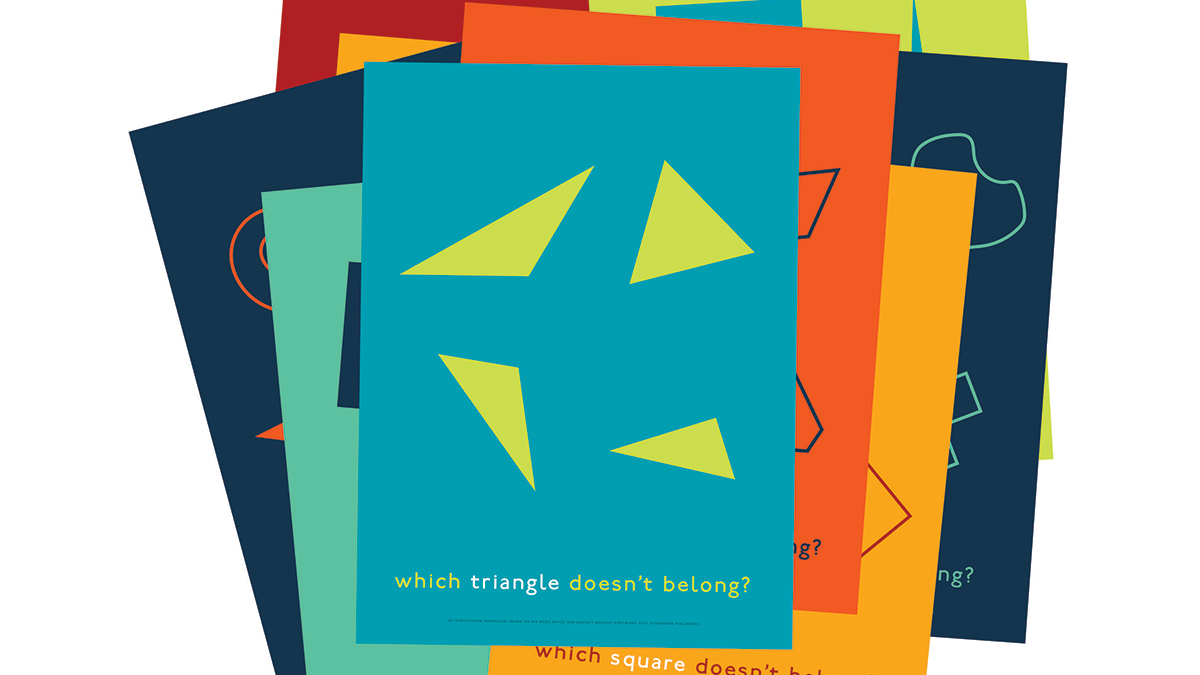(Cross-posted from Overthinking My Teaching)
Two and a half years ago, I was developing Which One Doesn’t Belong? (before Stenhouse had signed on to publish it). I went on a tour of elementary classrooms to talk with K—5 students all around the Twin Cities about these collections of shapes. I learned a tremendous amount of course, and much of that learning went into the Teacher Guide (which Stenhouse convinced me needed to exist).
I learned a lot, and I also noticed something.
Most of those classrooms had some form of shapes posters on the walls. Triangles, rectangles, squares, and rhombi were proudly and prominently displayed so that students would be surrounded by correct geometry vocabulary. Most of those shapes posters had something important (and unfortunate) in common with the shapes books in the school library and in the children’s homes.
There were rarely squares on the rectangle poster. All of the triangles were oriented with one side parallel to the ground, and most of them were equilateral. Sometimes the shapes had smiley faces. You and I know that a triangle is still a triangle, no matter its orientation. I can assure you not all elementary school children know this. While the vocabulary is good on your standard shapes poster, the math is not. (I decided not to link to examples—you can do your own search and report back if you find my claims exaggerated.)
This summer, Stenhouse is helping all of us to fix this. You can now preorder Which One Doesn’t Belong? shapes posters.
They come as a set of eight, with an insert in the spirit of the Which One Doesn’t Belong? Teacher Guide to help you facilitate student thinking and classroom conversation as they hang in your classroom.
1. Which SQUARE doesn’t belong?
2. Which RECTANGLE doesn’t belong?
3. Which RHOMBUS doesn’t belong?
4. Which HEXAGON doesn’t belong?
5. Which TRIANGLE doesn’t belong?
6. Which POLYGON doesn’t belong?
7. Which SHAPE doesn’t belong?
8. Which CURVE doesn’t belong?
These posters are filled with good mathematics. Consider the triangle poster on top of the pile. The triangle in the lower right is the only right triangle. The one in the upper right is the only equilateral triangle. The one in the upper left is the only isosceles triangle (or is it? do equilateral triangles count as isosceles?) The one in the lower left is the only one you can’t build out of the triangle in the lower right. Students will notice side lengths, angle measures, orientation, composition and decomposition, and more properties of triangles. Some will complain that not all of them are triangles (“too pointy” or “doesn’t have a bottom”). These posters let you and your students sit with—and play with—these ideas over a period of weeks or months.
So as you plan your back-to-school classroom organizing and decoration, I hope you’ll consider making space on your walls for these posters. And I definitely hope you’ll share your students’ ideas here and on Twitter.
Available for pre-order now. They’ll ship in early August.

This is great 😀
Are there any specific learning theories you base your work on?
Deep and interesting question, Lea! The answer is probably not explicitly, but I’ve certainly read my share of theory over the years, and it’s surely had an impact. Anna Sfard’s attention to the roles of language and participation in social interactions is influential, for sure. Similar ideas are implicit in Imre Lakatos’s Proofs and Refutations, which likens the learning of a classroom of students to the development of mathematical ideas in the larger community. And all of the research work conducted by the Cognitively Guided Instruction (CGI) team at University of Wisconsin and elsewhere is deeply influential, too.